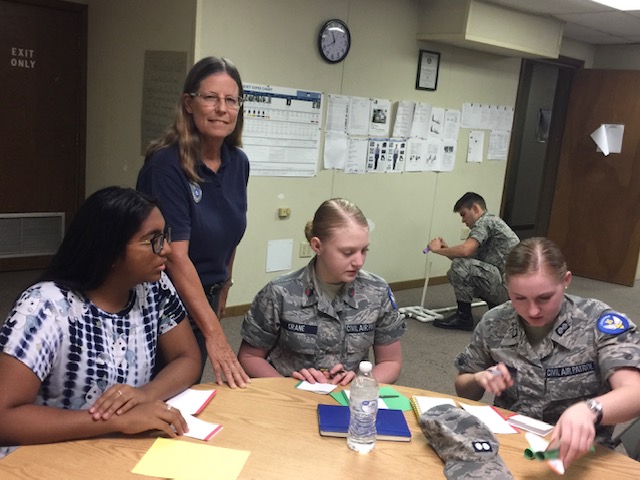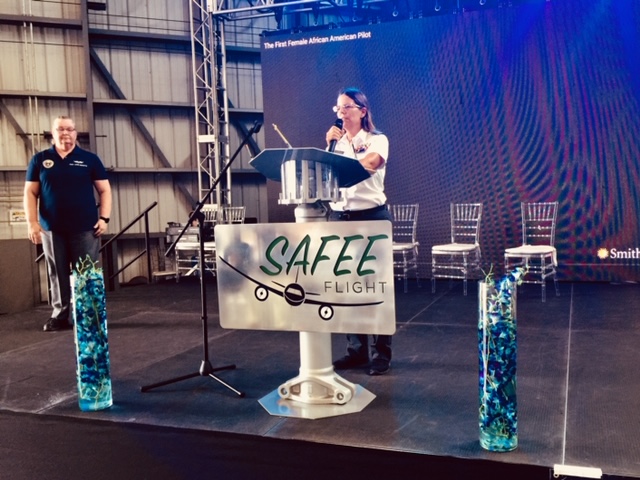Florida DAE Lt. Col. Bonnie Hinck (Baldatti) says CAP gives her a chance to give back to her country
Posted on October 7, 2020 at 12:55 PM by Virginia Smith
 |
| Lt. Col. Bonnie Hinck (Baldatti), Florida Wing DAE, believes it is important to give back to CAP, which sparked her flying career. |
October 8, 2020
Meet Lt. Col. Bonnie Hinck (Baldatti), Florida Wing Director of Aerospace Education (DAE). She first joined CAP when she was in college, and that led to her career as a commercial pilot when few women worked in the field. She has flown 4,500 hours and holds an Airline Transport Pilot’s license. Now working in the Aerospace Education mission field, she feels her aviation experiences may be of benefit to seniors and cadets. Of the latter, she says "CAP can help lead the way to their aviation careers." CAP, she says, helps her give back to her country. We asked Lt. Col. Hinck some questions about her career with Civil Air Patrol. Her answers follow:
Current duty position:
Florida Wing Director of Aerospace Education (DAE)
How many years have you been in Civil Air Patrol?
18 years
Tell us about your CAP career path that led to your current role?
Back in 1976, I joined the Civil Air Patrol as a 19-year-old senior member of Group 18 in the Florida Wing. I held numerous positions as needed at that time as Group 18 transitioned into Group 10. With a desire to actively fly, I transferred into the Miami Senior Squadron One and flew coastline CAP Sunset Patrols. During my time in the squadron, I had a find and a save and served in many positions, including Deputy Commander and Commander. In 1982 I transitioned into a professional flying career. At that time my schedule of relocating and commuting did not allow me to actively continue in CAP until years later.
In 2006, I rejoined CAP and became a member of the Homestead ARB Cadet Squadron (SER-FL-279) after deciding that it was time to give back as a thanks for launching my aviation career. Guess what they needed? An Aerospace Education Officer. This was a first for me and a perfect fit. I served as the Primary AEO of FL-279 up until 2017, when I was appointed to be the Group 7 AEO. Serving as the Group 7 AEO has been one of the most rewarding experiences that I’ve ever had. In January of this year, I accepted the position of Florida Wing Director of Aerospace Education, and a new challenge.
Tell us about your aerospace education background and career as well as any awards you'd like to mention.
First of all, I have a dual career, in part, because of CAP. My initial career is that of a music teacher and band director, and I have held that position from 1979-1982 and 1992 to the present. I attended the University of Miami School of Music with a scholarship and have since served with the UM School of Music Band of the Hour Association of Alumni and Friends Board of Directors for the last 18 years. In 2009 I was inducted into the Band of the Hour Hall of Fame. My desire was to give back to the University of Miami and the Civil Air Patrol for making my dual career possible.
My aerospace background includes flying with over 4,500 hours, an Airline Transport Pilot’s license, Flight Engineer Turbojet Powered license and Pan American Ground School and Flight Training.
Civil Air Patrol awards include:
- Florida Wing CAP 2012 Aerospace Education Circle of Excellence Award
- Commander’s Commendation Award 2012
- A. Scott Crossfield Aerospace Education Master Education Award 2014
- Achievement Award for Outstanding Duty Performance 2018
How did you come to be a CAP member?
I joined CAP when I was in college and also began my training for a future aviation career. This career was made possible by the Civil Air Patrol.
We understand that you worked as a commercial airline pilot when few women did back in the 1980s. Please tell us more about that experience.
My experiences and training in CAP back in the 1970s-1980s paved the way for my dual career in aviation. While in CAP and beginning my first career as a band director, I received my Private, Instrument, Multi-Engine and Commercial licenses and built up time flying CAP coastline Sunset Patrols, University of Miami survey flights and flew as the pilot for WGBS and WINZ traffic patrols. Being a person who tends to be at the right place at the right time, I was offered a job with Air Cargo America flying DC-3s with only 350 hours. I then transitioned from teaching music to flying. In the 1980s I moved up to flying for Provincetown-Boston Airways (PBA).
In 1987, after logging thousands of hours, I was hired by Pan American and became one of the pioneering women to fly for a major commercial airline. That experience will last me a lifetime, and I have Civil Air Patrol to thank for my dual career and outstanding aviation opportunity. And now you know why I’m giving back to CAP.
Why do you work in the Aerospace Education mission area, and why do you encourage youth in the AE area?
I feel that my experiences and training in the aerospace field may be beneficial to cadets and senior members. There is a tremendous need for skilled labor in the aviation field, especially pilots. Even today, there are very few female pilots in the military and the major airlines. Now’s the time to encourage our youth, and CAP can help lead the way to their aviation careers.
What is the best advice you have for working with AEMs?
The best advice that I have for working with AEMs is to keep them informed of upcoming activities and events. I believe that there should be an effort to make a connection between the squadrons and the AEMs. Invite an AEM to a local CAP meeting.
Do you have any suggestions for how to conduct outreach in schools and communities working with students and recruiting AEMs?
Reach out to the local School Board, schools and teachers and plan to attend an event. Plan on attending Career Day at the schools in your area. Include cadets if they are available. Reach out to the teachers to join as AEMs or as a CAP senior member. The students may also be interested in joining as a cadet. Students who do participate in the ACE Program or have a teacher who is an AEM may want to transition to a squadron at a future date. This program is a great recruiting tool. Mention to both the schools and the community the benefits of the CAP STEM kit program. Give a hands-on demonstration on how a STEM Kit works and let them try it out. Get in contact with community leaders and plan to attend local events.
What is the best advice for a new AE officer working with cadets?
My advice for a new AE Officer working with cadets or seniors is to have a mentor. Familiarize yourself with the Aerospace Education Officer’s Handbook and begin your specialty track in AE. Once you have begun your foundation in Aerospace Education, reach out to the cadets and seniors and begin your journey. Ask them to assist you with you lessons and activities. Get everyone involved, and that will make the AE activity more enjoyable for everyone.
Please tell an anecdote of a rewarding experience working in CAP.
It is rewarding to see the faces of the cadets when they come out the plane or glider after their first orientation flight. I know how it felt in my first hour of flight training in a CAP plane, and it led me to a new career! The Civil Air Patrol has become my second family and I love when we work together, and in the end we are all better for it. Giving back to each other and our country is what it’s all about!
 |
 |
| Left, Lt. Col. Bonnie Hinck (Baldatti) when she was a commercial pilot and, right, speaking at a Showcasing Aviation for Empowering Education (SAFEE) Flight event |



